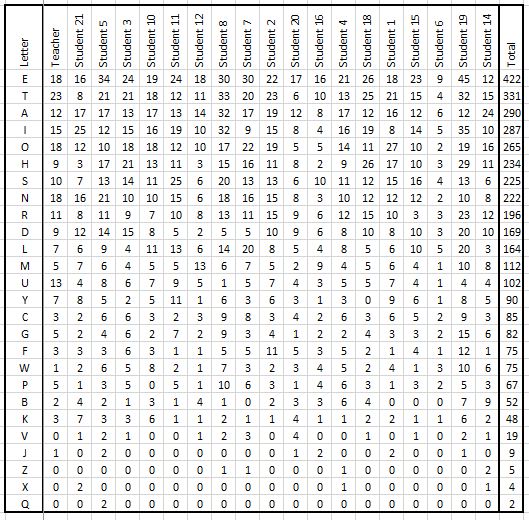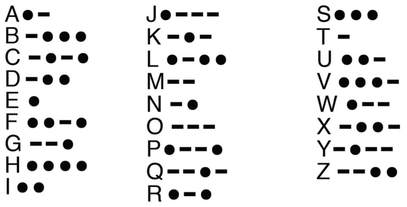The Investigation Page - Things that make you go 'hmmm'?
Our Wonder Wall
This space is dedicated to us and our SPARK investigations this year. As we explore, we'll record our findings here so that others can share in our discoveries.
To get us started, here's a question asked and solved by our problem solving team last year:
To get us started, here's a question asked and solved by our problem solving team last year:
Quick Links:
1. Which are the most commonly used letters in the English language?
2. Coming soon ... be sure to share your investigation ideas with Pak Matt to see your work here.
2. Coming soon ... be sure to share your investigation ideas with Pak Matt to see your work here.
Which are the most commonly used letters in the English language?
Related questions:
How did Samuel Morse invent his famous code? Why are typewriter keys arranged as they are, and not in alphabetical order? How did they decide how many of each tile to place in a Scrabble set, and how many points each letter should be worth? How can I use Maths to help me win at Hangman and Wheel of Fortune?
Aim: We've heard in conversation that 'e' is the most used letter in the English language, but which letters come next and in what order? The aim of this investigation is to answer each of the questions above by conducting our own study of the reading material in our room.
Hypothesis: That 'e' will be the most commonly used letter, with 'x' and 'z' the least commonly used. We're not sure how the other letters will be arranged but we're keen to find out.
Method:
1. Work as a team to study 1000 common English words in fiction and non-fiction print, to determine the number and types of letters used.
2. Collect a book, magazine or piece of reading material from amongst the classroom library.
3. Turn to a random page and count 50 words on that page, marking the first and last words.
4. Draw a table including each letter of the alphabet.
5. Beginning with the first word, place a score beside each letter of the word in the table described above.
6. Continue for all 50 words.
7. Count the tally marks.
8. Combine the class results into one large table, giving the results of 20 x 50 (1000 words).
9. Record a results table showing the frequency of the letters in order.
10. Compare the results with other existing studies, such as the one by Samuel Morse and that conducted by the Oxford Dictionary.
Results:
According to our study, the most commonly used letters in the English language are:
Hypothesis: That 'e' will be the most commonly used letter, with 'x' and 'z' the least commonly used. We're not sure how the other letters will be arranged but we're keen to find out.
Method:
1. Work as a team to study 1000 common English words in fiction and non-fiction print, to determine the number and types of letters used.
2. Collect a book, magazine or piece of reading material from amongst the classroom library.
3. Turn to a random page and count 50 words on that page, marking the first and last words.
4. Draw a table including each letter of the alphabet.
5. Beginning with the first word, place a score beside each letter of the word in the table described above.
6. Continue for all 50 words.
7. Count the tally marks.
8. Combine the class results into one large table, giving the results of 20 x 50 (1000 words).
9. Record a results table showing the frequency of the letters in order.
10. Compare the results with other existing studies, such as the one by Samuel Morse and that conducted by the Oxford Dictionary.
Results:
According to our study, the most commonly used letters in the English language are:
Discussion:
This study of more than 900 words and 3600 letters showed that some of the most commonly used letters in English (in our sample) are E, T, A, I, O, H, S, N, R, D, L, M and U. This matched with our hypothesis, but provided us with a lot more information too.
So how can we use that information to help us design keyboards and codes, and to create and win at games? Let's dig a little deeper and put our new found discoveries to use in the classroom.
Applications:
Become a Hangman Champion
Raining outside? On a long boring road trip? Just a good old fashioned Hangman fan? Why not put your discoveries to the test to become the ultimate Hangman Champion?
Next time you play, try starting by guessing the letters you now know are the most common, or, when it's your turn to choose a word, try to select a word that uses some of the least commonly used letters. Here's an idea to get you started.
This study of more than 900 words and 3600 letters showed that some of the most commonly used letters in English (in our sample) are E, T, A, I, O, H, S, N, R, D, L, M and U. This matched with our hypothesis, but provided us with a lot more information too.
So how can we use that information to help us design keyboards and codes, and to create and win at games? Let's dig a little deeper and put our new found discoveries to use in the classroom.
Applications:
Become a Hangman Champion
Raining outside? On a long boring road trip? Just a good old fashioned Hangman fan? Why not put your discoveries to the test to become the ultimate Hangman Champion?
Next time you play, try starting by guessing the letters you now know are the most common, or, when it's your turn to choose a word, try to select a word that uses some of the least commonly used letters. Here's an idea to get you started.
Axolotl
Can you think of a word which is even harder to guess? Test it out on your family and friends.
|
Follow in the footsteps of Samuel Morse
Samuel Morse is a famous American painter and inventor who lived in the late 1700 and early 1800s. He is perhaps most well known for being the co-creator of a telegraph messaging system now called Morse Code. It worked by sending a series of electrical signals, both short (dots) and long (dashes), via electrical cable from a writer to a receiver. By creating a code that both the writer and receiver could use, these dots and dashes could then be translated into words. This is the code he created. |
Can you see how he designed his code? Knowing what you now do about the most commonly used letters in English, would you design it the same way? Can you think of an easier system?
If you'd like to learn Morse code, or would like to try writing a message in it, click on the pic below. It works just as well in Bahasa Indonesia.
If you'd like to learn Morse code, or would like to try writing a message in it, click on the pic below. It works just as well in Bahasa Indonesia.
Interested in learning more about the most commonly used letters in English? Try this Oxford Dictionary resource.





